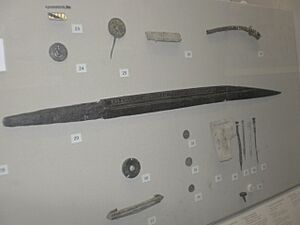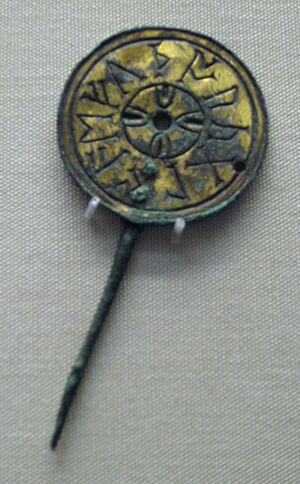Seax of Beagnoth facts for kids
Quick facts for kids Seax of Beagnoth |
|
|---|---|

The Seax of Beagnoth on display at the British Museum
|
|
| Material | Iron (inlaid with copper, brass and silver) |
| Size | Length: 72.1 cm (28.4 in) Width: 38.7 mm (1.52 in) Thickness: 8.2 mm (0.32 in) |
| Weight | 985 g |
| Writing | Runic, Old English |
| Created | 10th century |
| Period/culture | Late Anglo-Saxon |
| Discovered | 1857; River Thames, Battersea |
| Present location | Room 41, British Museum, London |
| Registration | 1857,0623.1 |
The Seax of Beagnoth (also called the Thames scramasax) is a special knife from the 10th century. It was made by the Anglo-Saxon people. This unique knife was found in 1857 in the River Thames in London. Today, you can see it at the British Museum.
It's not just any knife! It's a fancy weapon, decorated with cool patterns. These patterns are made from copper, brass, and silver wires pressed into the metal. One side of the blade has something very rare. It shows the only full set of the twenty-eight Anglo-Saxon runic alphabet letters. Runes are like ancient letters or symbols. The blade also has the name "Beagnoth" written in runes. People think these runes might have had a magical meaning. Beagnoth was probably the owner of the knife or the person who made it.
While many old swords and knives have writing on them, the Seax of Beagnoth is one of the very few with runes on its blade.
Contents
Finding the Ancient Knife
A worker named Henry J. Briggs found this amazing knife. He discovered it in the River Thames near Battersea in early 1857. Briggs sold the knife to the British Museum.
On May 21, 1857, it was shown at a meeting of experts. An expert from the British Museum, Augustus Wollaston Franks, described it. He said it looked like a "scramasax," a type of knife that is very rare in England. He also noted the "row of runic characters inlaid in gold." Since then, it's often been called the Thames scramasax. However, experts now prefer to call this type of weapon a long seax.
What Does the Seax Look Like?
The Seax of Beagnoth is an iron knife with one sharp edge. It has a long, pointed tip. The whole knife is about 72.1 centimeters (about 28 inches) long. A part called the tang, which would have held a handle, is 17.0 centimeters long. The blade itself is 55.1 centimeters long. The handle that was once attached to the tang is now gone.
This knife was clearly made to be special. Both sides of the blade are decorated with cool geometric patterns. These patterns were made by hammering thin strips of twisted copper, brass, and silver wire into grooves cut into the blade. There are also triangles and diamond shapes made from copper, brass, and silver. This way of decorating weapons was popular. It was used on knives and spearheads by Germanic and Anglo-Saxon people in the 9th and 10th centuries. Viking swords from the same time also used this method.
Each side of the seax has a deep line running down the middle of the blade. Above this line is a long rectangular area. This area is bordered by inlaid copper strips. On one side, this area is filled with a diamond pattern in silver and copper. This might have been made to look like a special metalworking technique called pattern welding.
The other side of the blade has two runic inscriptions. These are made with brass and silver wire. The writing on the left is the full twenty-eight letters of the Anglo-Saxon runic alphabet, also known as the futhorc. The writing on the right is separated by a zigzag pattern. It spells the name Beagnoþ or Beagnoth ᛒᛠᚷᚾᚩᚦ. Most people believe this is the name of the person who made the blade or its first owner.
The Runic Inscriptions
The inscription of the futhorc (the runic alphabet) looks like this:
| Order on Seax | Standard rune | UCS | Old English name | Transliteration | Order in Vienna Codex |
|---|---|---|---|---|---|
| 1 | ᚠ | feoh | f | 1 | |
| 2 | ᚢ | ur | u | 2 | |
| 3 | ᚦ | þorn | þ | 3 | |
| 4 | ᚩ | ós | o | 4 | |
| 5 | ᚱ | rad | r | 5 | |
| 6 | ᚳ | cen | c | 6 | |
| 7 | ᚷ | gyfu | g | 7 | |
| 8 | ᚹ | wynn | w | 8 | |
| 9 | ᚻ | hægl | h | 9 | |
| 10 | ᚾ | nyd | n | 10 | |
| 11 | ᛁ | is | i | 11 | |
| 12 | ᛄ | ger | j | 12 | |
| 13 | ᛇ | eoh | ɨ | 13 | |
| 14 | ᛈ | peorð | p | 14 | |
| 15 | ᛉ | eolh | x | 15 | |
| 16 | ᛋ | sigel (written as ᚴ, see below) | s | 16 | |
| 17 | ᛏ | Tiw | t | 17 | |
| 18 | ᛒ | beorc | b | 18 | |
| 19 | ᛖ | eh | e | 19 | |
| 20 | ᛝ | ing | ŋ | 22 | |
| 21 | ᛞ | dæg | d | 23 | |
| 22 | ᛚ | lagu | l | 21 | |
| 23 | ᛗ | mann | m | 20 | |
| 24 | ᛟ | eþel (written as the "lantern rune" |
œ | 24 | |
| 25 | ᚪ | ac | a | 25 | |
| 26 | ᚫ | æsc | æ | 26 | |
| 27 | ᚣ | yr | y | 28 | |
| 28 | ᛠ | ear | ea | 27 |
There are a few interesting things about this runic inscription. The order of some runes is a bit different from other known lists. For example, runes 20-23 are mixed up. Also, the last two runes (27-28) are swapped compared to a famous old book called the Vienna Codex.
Some of the rune shapes are also unusual. For example, rune 12 (ger) looks different from how it usually appears. Rune 16 (sigel) is very small and seems squeezed in. This might mean it was added later. These differences could mean the person who made the inscription wasn't an expert in runes. Or, it might have been hard to make the exact shapes when inlaying the wire.
The inscription of the name Beagnoth is as follows:
The name "Beagnoth" itself doesn't have any strange features. However, there are two odd designs at the top right of the name. No one has been able to explain what these designs mean.
When and Where Was It Made?
Similar knives (seaxes) have been found across Europe, dating from the 7th to the 11th centuries. In England, the oldest ones are from 7th-century graves. Knives found alone, like the Seax of Beagnoth, usually date from the 9th and 10th centuries. The Seax of Beagnoth is believed to be from the 10th century.
Several similar seaxes have been found in southern England. One found in Berkshire is so much like the Seax of Beagnoth that they might have been made in the same workshop!
Experts think the seax might have come from Kent, a region in southern England. This is because its inscription only uses the original twenty-eight Anglo-Saxon runes. It doesn't include extra letters used in northern England at that time.
The name "Beagnoth" also points to Kent. This name appears in old Kentish records. For example, one Beagnoth was a witness to an important document in Kent around 748–760. Another Beagnoth was a monk from Kent in 803. The name "Beagnoth" comes from Old English words meaning "ring, bracelet" and "boldness." So, it can be translated as "Ringbold."
Why Is This Knife Important?
The Seax of Beagnoth is very important for two main reasons. First, it's a rare example of an Anglo-Saxon weapon with runes on it. Second, its runic inscription is the only known complete example of the twenty-eight-letter Anglo-Saxon futhorc (alphabet) found on an object.
Runes on Blades
People in Northern Europe often carved runes onto weapons, especially swords. They believed runes could offer magical protection. For example, an old Norse poem tells how a valkyrie (a female warrior spirit) teaches a hero to carve runes on his sword for victory.
Another old English poem, Beowulf, also talks about carving runes on swords. It mentions writing the sword owner's name in runes on the handle. This practice is confirmed by other old sword parts found in England.
The Seax of Beagnoth is special because it's the only known Anglo-Saxon weapon with a runic inscription right on its blade. Most other runic inscriptions on weapons are on the handle or scabbard (the sword's cover).
So, who was Beagnoth? The Beowulf poem suggests it could be the original owner's name. But it's not certain. Old weapons often had the name of the person who made them, or even the person who gave them as a gift. An expert named Raymond Page thought of four possibilities for the name "Beagnoth":
- It could be the name of the smith who made the seax.
- It could be the name of the rune-master who wrote the runes. This might have added extra magic.
- It could be the name of the original owner. The seax is very impressive, and an owner would be proud to have their name on it.
- It could be the name of someone who gave the seax as a present. It's a fancy enough item to be a great gift.
We can't know for sure which one is correct.
The Inscribed Futhorc

The runic inscription on the seax not only tells us about Beagnoth but also gives us a rare look at the twenty-eight-letter Anglo-Saxon runic alphabet. While older runic alphabets are common, full examples of the Anglo-Saxon futhorc are rare on actual objects. Most are found in old books. This seax is the only known object with the complete basic twenty-eight-letter Anglo-Saxon runic alphabet.
It's not clear why the entire alphabet was carved on the knife. Experts think it wasn't just for decoration. It likely had a magical meaning. Carving runes on swords for protection was an old tradition. By the 9th century, knowledge of runes might have been fading in Kent. So, the owner might have asked for this old-style runic inscription to make the knife seem even more important. The small errors in the runes suggest that the smith who made the seax might not have been an expert in runes. They might have copied them from a book.
|
See also
- Anglo-Saxon art
- Franks Casket
- Viking Age arms and armour
- Wetlands and islands in Germanic paganism




